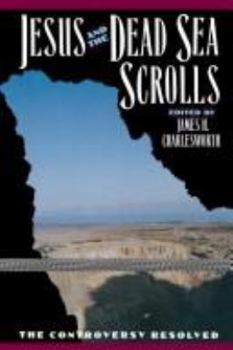Jesus and the Dead Sea Scrolls
(Part of the Anchor Bible Reference Library Series and The Anchor Yale Bible Reference Library Series)
Select Format
Select Condition 
Book Overview
A leading expert on the Dead Sea Scrolls explains why they are among the most important archaeological finds in history, and explores how they have revolutionized our understanding of Jesus. This description may be from another edition of this product.
Format:Hardcover
Language:English
ISBN:0385248636
ISBN13:9780385248631
Release Date:January 1993
Publisher:Doubleday Books
Length:370 Pages
Weight:1.75 lbs.
Dimensions:1.3" x 6.4" x 9.6"
Customer Reviews
2 ratings
Good Dead Sea Scrolls Intoduction
Published by Thriftbooks.com User , 21 years ago
This is a very good introduction to the Dead Sea Scrolls. James Charlesworth is an amazing (and readable) scholar. I stumbled onto this while trying to learn more history about Jesus (reading David Flusser, N.T. Wright, Brad Young; didn't waste much time reading John Dominic Crossan). (I'm not formally trained in religion, not a minister). For a lay person trying to learn a lot about the Dead Sea Scrolls, this book is needed along with books by Lawrence Schiffman (Reclaiming the Dead Sea Scrolls) and Hershel Shanks. With this collection, any lay person will know just about every major issue that is relevant.
helpful background to 1st century southern levant
Published by Thriftbooks.com User , 24 years ago
Over the years, the Anchor Bible Reference Library (ABRL) has published an assortment of scholarly books on archeology in the Levant, Jewish history and the origins of Christianity. Jesus and the Dead Sea Scrolls, edited by James H. Charlesworth (©1992) is a nice addition to this series and certainly worthy of examination by any interested in the period of the first centuries BC and AD. This work, is a compilation of articles by renown scholars focusing on areas of commonalty and differences between the teachings of Jesus and the writings found in the caves of Qumrân. For example, although some eschatological exegesis and scriptural preferences between Jesus and the Essene community at Qumrân can be catalogued, Jesus' ministry was also profoundly different from the Essenes, as well as different from other Jewish leaders including the Pharisees. The Essenes were exclusionary and ritualistic, Jesus demonstrated an inclination to accept all sincere followers. Jesus' parables could be comprehended by all (at least superficially), while the Dead Sea Scrolls are often noted for their obtuseness. The Essenes were even stricter with their interpretation of Mosaic law than the Pharisees. Jesus took a more liberal view on this matter. Yet both groups were devoted to prayer and both acknowledged "the Holy Spirit" (rwh hqws) as did other Jewish leaders. Comparisons between Essene writings and the Torah abound. For example, Deuteronomy 21:22 commands that a capital offense be punished by death followed by hanging upon a tree for public display. However in the Temple Scroll, this sequence is reversed--the delinquent is to be hanged until death--i.e., crucifixion. Further comparison of symbolic references are made between Jesus and the Essenes. The Qumrân community placed great emphasis on sacrifice and atonement in the Temple at Jerusale--in fact, the Righteous Teacher referred to in many scrolls is thought by some scholars to have been a High Priest and a member of the Zadok family line. Jesus, on the other hand, regarded the Temple as a house of prayer and offered forgiveness outside of the temple cult. The scrolls prepared the community about the coming war against the "sons of darkness", while Jesus instructed his disciples to love their enemies--including Gentiles. The common meal for Essenes signified a conformity to purity rituals, while Christians came to accept this as an expression of Jesus' sacrifice. A later chapter comments on how Jesus saw the Temple and the taxes collected on its behalf as an oppression of the poor. One item of concern for biblical scholars has been the apparent discrepancy between the synoptic gospels and the account in John regarding the Last Supper--the former indicate this was the Passover meal, while the latter synchronizes Jesus' death with the slaughter of the paschal lamb. Scholars have established that two liturgical calendars were in use in the first century-





